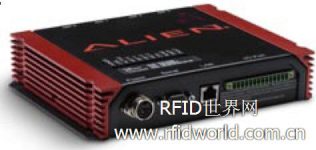
Yogurt maker Daisy Brand benefits from RFID data analysis
[ad_1]
Daisy Brand, a yogurt manufacturer, has taken its RFID application to a new level. Kevin Brown, the company’s director of information systems, said that the company now uses RFID data to better manage product promotion and high-volume products. Daisy uses RFID to track the arrival time of goods and the number of replenishments, and manages the release of new white cheese products and their sour cream products through data analysis.
Daisy Brand recently upgraded the RFID hardware of its application system, using Alien Technology’s ALR9900 reader on forklifts and entrances and exits. The yogurt manufacturer claims that the ALR9900 has improved the reading rate, and now only one antenna is used for each forklift.

Alien Technology’s ALR9900 reader
Daisy first adopted the RFID system in 2005 in Garland, Texas. Now the company has adopted a similar system in its new manufacturing plant in Casa Grande, Arizona, which will officially start operations in the second half of this year.
Although Daisy Brand’s original goal was to test RFID tag placement and hardware capabilities in Garland, the company has now moved to the next stage-the use of RFID data. “Many of our activities are carried out around Wal-Mart Retail Link information,” Brown said. Wal-Mart Retail Link refers to an external network service where Wal-Mart shares supply chain data with suppliers.
According to Brown, data analysis plays an extremely important role in promotional activities, new product launches and major shopping festivals. Daisy Brand has used RFID data to identify which container is empty and when it can be restocked. “Our products are perishable,” Brown said. “We want to see the products on the shelves in time-but not too early.” With the RFID system, Daisy managers can track the speed of the products on the shelves in various Wal-Mart stores. “If the product is on the shelves a week earlier, it will be sold out before the promotion starts.”
Alien Omni-Squiggle Gen 2 RFID tags are affixed to all pallets and boxes shipped by Daisy Brand to Wal-Mart’s RFID stores. When the labeled pallets arrive at the Wal-Mart RFID store, the reader reads the ID numbers of the tags and sends them to Wal-Mart’s back-end system. These data are then displayed on Retail Link to inform the manufacturer that the product has been put on the shelf. When the empty box is sent to the garbage compressor, the reader reads the tag again, and the system informs Daisy that the goods have been sold through Retail Link.
“We want to know the information about the product on the shelf,” Brown said. “If the sales on a certain day are zero, we want to know why. This information is especially important in a promotional event.”
When the new Daisy Brand white cheese product is launched, Brown and his team can understand the product’s shelf time and monitor the time it takes to sell it. If there is a problem, such as an empty cabinet during the promotion period, the company can send relevant personnel to the store to correct the problem.
At the Garland warehouse, Daisy Brand initially used Alien 9780 readers on forklifts. This reader is bistable and requires a separate antenna to send or receive RF signals. Since the replacement of the smaller ALR9900 reader, the new reader is monostable, with only one antenna to receive and send signals, so it will not hinder the operation of the forklift driver.
At the entrance and exit, the company replaced the original bistable Alien 9800 reader with the monostable ALR9900 reader. Brown said the upgrade improved the read rate. The Alien 9800 uses the same number of antennas as the Alien 9800, but it receives better results, because all the antennas can receive and send data. Before, only half of the antennas can receive and the other half of the antennas are used to send and send data. The Daisy Brand system uses GlobeRanger’s Motion Edgeware to collect reader data.
Brown said the companies hope that some suppliers will also participate in the project. This includes suppliers of raw materials for Daisy Brand, such as milk and cream, including boxes, cups and lids for yogurt. Although Daisy currently uses paper records to track the arrival and use of materials, the company prefers to use RFID, because RFID can accurately understand the products consumed, which is conducive to next year’s order.
[ad_2]




